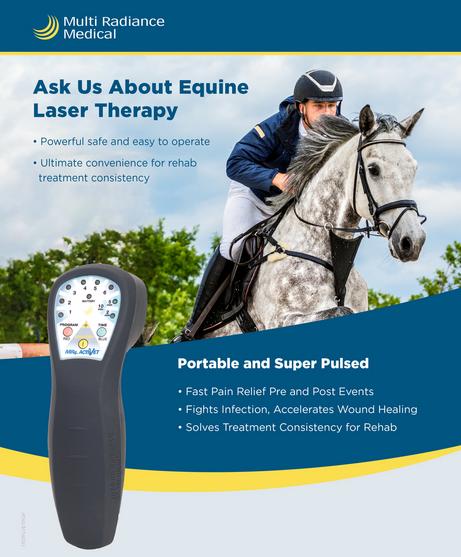Just How Laser Therapy in Equine Treatment Is Changing Veterinary Look After Equines
Laser therapy has actually arised as a transformative strategy in equine vet treatment, giving a non-invasive solution that expedites healing and improves general health and wellness. The mobility and adaptability of laser treatment devices further underscore their expanding necessity among vets.

Recognizing Laser Treatment
Understanding laser therapy is important for appreciating its duty in equine treatment. Laser treatment, additionally called photobiomodulation, entails the application of particular wavelengths of light to tissues, which can result in numerous biological results. This healing technique takes advantage of the power of light energy to pass through the skin and underlying cells, promoting mobile procedures and improving tissue repair work.
The technology behind laser treatment is grounded in the concept of photochemistry, where photons are taken in by chromophores within cells, leading to raised ATP production and modulation of responsive oxygen species. This, consequently, advertises cellular spreading, decreases swelling, and speeds up healing. Vet specialists utilize various kinds of lasers, consisting of low-level lasers (LLLT) and high-power Class IV lasers, depending upon the specific restorative goals and the nature of the equine problem being treated.
Various laser wavelengths and power settings are very carefully selected to target different tissue midsts and achieve wanted medical end results. Safety procedures are extremely important, as incorrect use can result in thermal damages or suboptimal therapeutic impacts. Hence, a detailed understanding of laser treatment's systems and applications is crucial for its efficient execution in equine vet practice.
Benefits for Horse Health
The myriad benefits of laser treatment for equine health include improved recovery, discomfort decrease, and boosted wheelchair. This innovative therapy modality leverages particular wavelengths of light to permeate cells, promoting mobile feature and advertising quick cells repair. The non-invasive nature of laser therapy guarantees very little stress and anxiety and discomfort for the steed, helping with a smoother healing procedure.

Improved movement is another crucial advantage, especially for performance and working equines. By minimizing inflammation and discomfort, and improving tissue fixing, laser therapy aids in bring back joint function and muscular tissue flexibility. The collective impact of these benefits is not just a quicker return to regular activity yet likewise an overall improvement in the horse's lifestyle. Thus, laser treatment stands as a transformative tool in contemporary equine veterinary treatment.
Common Problems Treated
Laser therapy has actually arised as a functional treatment alternative for a variety of common equine conditions. Furthermore, laser treatment is reliable for problems like osteo arthritis, go to the website where it assists alleviate joint swelling and promote cells repair work.
Wound management is one more area where laser treatment has actually revealed considerable pledge. Persistent injuries or slow-healing abscess can be specifically difficult in equines, however laser therapy improves cellular regeneration and improves blood flow, thus speeding up the healing process. Laser therapies have been effectively utilized in handling hoof conditions such as laminitis and abscesses, reducing discomfort and advertising faster recovery.
Horse professional athletes commonly experience from performance-related problems like muscular tissue discomfort and stress cracks. Laser treatment aids in decreasing muscle exhaustion and expedites the recovery of micro-injuries, hence ensuring that steeds return to come to a head performance much more quickly. By resolving these varied conditions, laser treatment is transforming the landscape of vet treatment, supplying a non-invasive, effective choice to standard treatments.
Modern Technology Behind Laser Therapy

Laser gadgets made use of in veterinary medicine usually utilize low-level laser therapy (LLLT) or cool laser treatment. Unlike high-powered surgical lasers, these tools operate at lower power degrees, optimizing therapeutic benefits while decreasing thermal damage. The energy from the laser light promotes adenosine triphosphate (ATP) manufacturing, enhances cellular metabolic process, and increases cells repair processes.
Modern laser therapy tools for equine therapy is made with flexible setups to cater to the particular needs of different cells and problems. In addition, improvements in laser innovation have led to the development of mobile, Go Here portable gadgets, making it simpler for veterinarians to offer treatment in a selection of setups, from centers to stables.
Success Stories and Case Studies
Showcasing the substantial advantages of laser treatment, many success stories and study brighten its transformative influence on equine health. One such instance why not find out more includes a pure-blooded racehorse struggling with chronic tendonitis. Traditional therapies yielded marginal enhancement, but after integrating laser treatment into the routine, the horse exhibited substantial reductions in swelling and discomfort within weeks, eventually returning to competitive racing.
Another compelling example features a dressage equine identified with extreme pain in the back, limiting its performance. A veterinary group used low-level laser treatment (LLLT) to target the swollen locations, resulting in significant enhancement in adaptability and a notable decrease in pain. Over several sessions, the equine reclaimed its peak kind, showcasing the efficiency of laser therapy in attending to musculoskeletal concerns.
Additionally, a research performed at a leading equine facility checked out 50 equines with numerous soft tissue injuries treated with laser therapy. The outcomes stood out: 85% of the steeds showed increased recovery times and boosted mobility. These cases highlight the convenience and performance of laser treatment in equine medication, supplying a non-invasive, scientifically-backed strategy to boosting recuperation and performance in horses.
Conclusion
Laser therapy is transforming equine veterinary care by providing a non-invasive therapy that increases recovery, lowers swelling, and alleviates pain. With its performance in dealing with a series of conditions, from bone and joint injuries to chronic disorders like osteo arthritis, this innovation significantly boosts equine wellness and movement. The mobility and adaptability of laser therapy even more underscore its transformative effect on vet methods, solidifying its function as an essential device in contemporary equine health care.